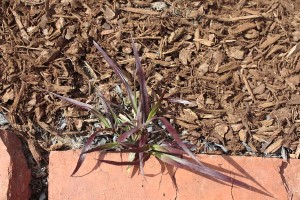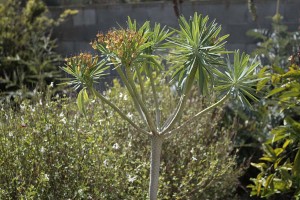This past winter I was noticing a weed popping up all around the yard that I hadn’t noticed before. I was mentioning it to John, and added, “I’m not sure what it is, though think it could be some sort of euphorbia.”
Then in the gently tactful way spouses have of correcting you and pointing out your blind spots he quietly cleared his throat and pointed to one of the four young potted plants we have around the garden of Euphorbia lambii, one of my dry garden-adapted plants from the Canary Islands. “Maybe it’s that?”
Uh, like duh. What else would it be?
Last year was the first that these plants bloomed, and this spring they bloomed with a vengeance. During sunny weather over the last few weeks I’ve heard little popping noises from the direction of the plants, and have come to the conclusion that the sounds were that of seed pods exploding and jettisoning the dust-like seed everywhere.
I may come to regret the day I introduced these to the garden, which according to my records is March 9, 2008.
Speaking of weedy plants, here’s another surprise seedling from the garden, a little baby red fountain grass, one of three seedlings I noticed this year. In recent years the related green fountain grass, Pennisetum setaceum has become a noxious (though stunningly beautiful) weed and has landed high on virtually every thou-shalt-not-plant list issued for California.  But many people gave a by to this related red plant. It was often pushed as being sterile and incapable of reproducing by seed, a piece of misinformation even I relayed in this blog. (I’ve corrected that earlier oops in case anyone reads that earlier post.) As you can see here it can reproduce by seed, though this form doesn’t spawn the same way regular fountain grass does. Nor is it immediately the same monster pest that feather grass (Nassella tenuissima) can be.
But many people gave a by to this related red plant. It was often pushed as being sterile and incapable of reproducing by seed, a piece of misinformation even I relayed in this blog. (I’ve corrected that earlier oops in case anyone reads that earlier post.) As you can see here it can reproduce by seed, though this form doesn’t spawn the same way regular fountain grass does. Nor is it immediately the same monster pest that feather grass (Nassella tenuissima) can be.
Poking around the web I found an updated plant description at San Marcos Growers that includes some interesting background on this plant:
Recent work in preparation for the grass sections of the Flora of North America, which will include naturalized and cultivated grasses, indicates that the name chosen for this plant will be Pennisetum advena or perhaps P. x advena. Dr. Joseph K. Wipff, previously with Texas A&M and now a turfgrass breeder, wrote the section on Pennisetum and has indicated that Red Fountain Grass is most likely a cross between P. setaceum and P. macrostachys (AKA ‘Burgundy Giant’). As a hybrid the name would most appropriately be Pennisetum x advena ‘Rubrum’. The latin word advena means “newly arrived” or “stranger.”
So is it safe to plant this form of fountain grass? Here’s my thinking: Hybrids between species are often sterile. (Think of mules, the offspring of a horse and a donkey.) But every now and then something happens that allows the hybrid to reproduce. Sometimes the seedlings will be just as nearly sterile as the immediate parent, but other times a mutation could render the seedling entirely fertile. In that latter scenario the nearly-sterile fountain grass could turn into something with the ugly invasive potential of its Pennisetum setaceum ancestor.
In other words, today I would be cautious and not plant it. Unfortunately, almost twenty years ago, we designed the front yard around a big mound of the stuff. The plants look stunning and move graciously in response to the breezes. Their size is perfect for the spot, and their red color is unmatched among other grasses. Every now and then I look at other options, like those recommended in the Don’t Plant a Pest brochure put out by the California Invasive Plant Council. But these lists often fall short in the alternatives they offer and end up reading like, “Cheesecake is bad for you. Would you like to eat this delicious raw rutabaga instead?” So…I’m still looking for the perfect replacement plant–hopefully some sort of native, but in the meantime I’m pulling the occasional seedlings.



